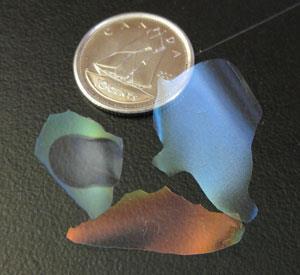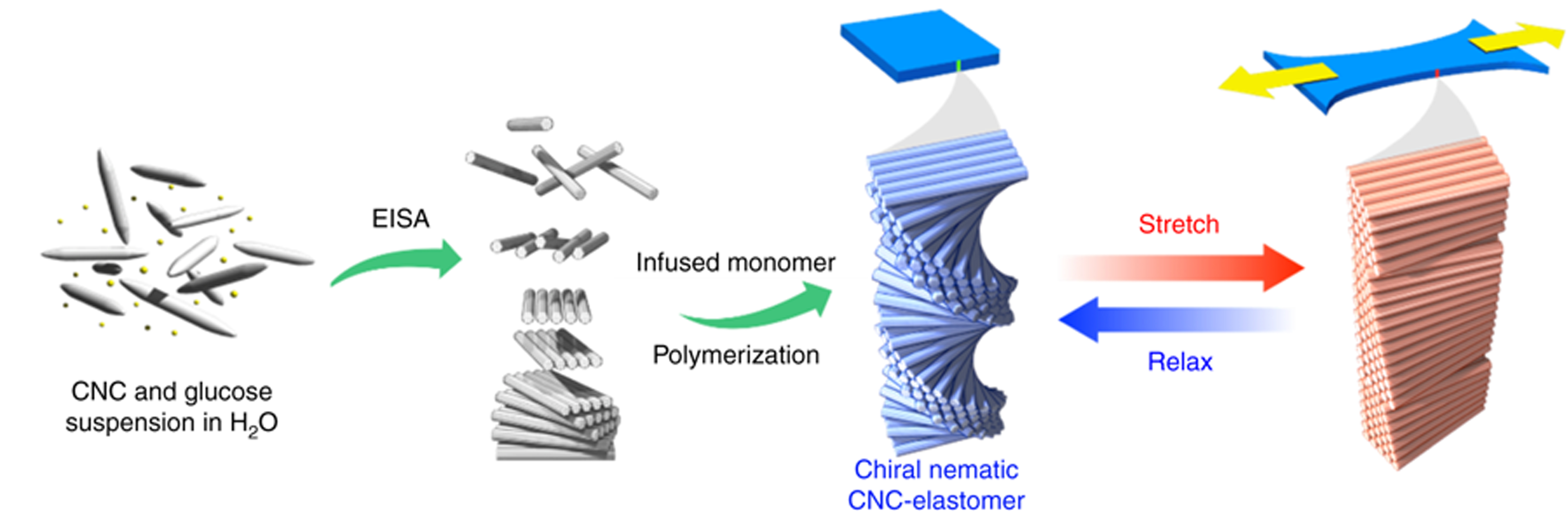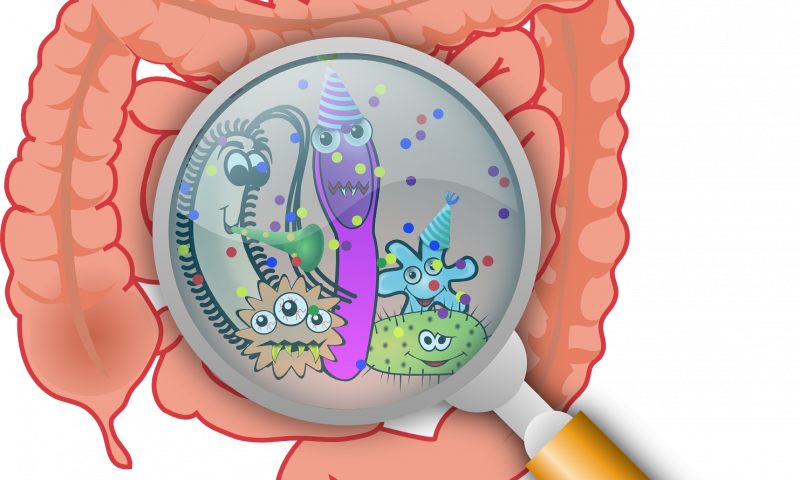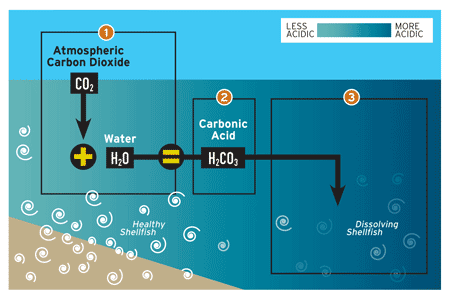Just a few months ago, Dr. MacLachlan and his research group from the University of British Columbia discovered some extraordinary new properties of an elastomer made with cellulose nanocrystals (CNCs), which is a biomass-derived substance. These CNCs are everywhere, and can even be obtained by “tak[ing] a piece of paper and treat[ing] [it] with sulfuric acid for 45 minutes,” as Dr. MacLachlan explained. When this abundant and environmentally friendly material was added to the elastomer, it gave the elastomer its optical properties. In other words, when it is stretched under cross-polarizers, the CNC-elastomer changed colour, depending on how much it was stretched!
Stretching the CNC-elastomer under cross-polarizers. Source: Nature Communications
The MacLachlan group started working with CNCs for their optical properties by accident, or as Dr.MacLachlan said, “Serendipity in Science.” When they were looking into cellulose nanocrystals for storing hydrogen, one of the hundreds of samples came out with a red colour, which initiated Dr. Maclachlan’s invested research on cellulose nanocrystals.

Colourful thin films made with cellulose nanocrystals. Source: Chemistry World
The research group was interested in incorporating CNCs into elastomers since previous studies demonstrated that CNC-incorporated materials, such as silica and resins, proved to be inflexible and fragile when stretched. Therefore, the research team decided to investigate different methods that could synthesize a uniform CNC/elastomer structure, which can be stretched and returned to its original form once removing the applied force. The CNCs were successfully incorporated into the elastomer with the help of a sugar additive that helps stabilize the elastomer through evaporation of the solvent. With the success of incorporating elastomer with CNC, this CNC elastomeric material can be further studied for its optical properties.
The MacLachlan group was able to see fascinating optical properties when putting the elastomer under crossed-polarizers. These crossed polarizers permit only one plane of light to hit the elastomer. This is what allows you to see the birefringent optical properties. Birefringence can occur when light enters a material with a very ordered structure. Due to this order, the light is bent into a different plane, while travelling at a variety of speeds. This is the reason why we see the light scattering off from the highly ordered structures in the stretched CNC-elastomer.
Under a high-powered scanning electron microscope, they were able to determine that the cellulose nanocrystals were arranged in a helical shape in the unstretched elastomer, and would start to unwind when the elastomer was stretched. This unwinding elastomer gives rise to unique optical properties.
When light interacts with the elastomeric material, it gets reflected and bent in different directions, depending on how much the cellulose nanocrystals helical structure unwinds. The extent to which the structure is unwound determines what new colours are visible in the material. In other words, the amount the material is stretched directly related to the colour that we see!

A simple depiction of how the elastomer was made by EISA (evaporation induced self-assembly) and how the cellulose nanocrystals change when stretched in the material. Source: Nature Communications
When the light interacts with the material, it gets reflected and bent in different directions, depending on how much the cellulose nanocrystals helical structure unwinds. The different degrees of unwound structure results in a new colour that we can see in the material. This means that the amount the material is stretched is directly related to the colour that we see!
The observed spectrum of colour we see in inversed when the analyzer is parallel with the polarizers. We see the complementary colours. Source: Nature Communications
The discovery of the optical properties in CNC-elastomer is a significant step in the right direction, which can later be used in many applications. The MacLachlan group is currently making a CNC-elastomer that does not require crossed polarizers so we would be able to see the colour change with our naked eye! This new optical property would open up new possibilities for how this material can be used in our daily lives.
Some future applications include applying a thin layer of CNC-elastomer onto bridge supports and buildings. This would be a major benefit for the residents in Vancouver, as we are in a high-risk earthquake zone. As a result, the thin film could help us determine if our buildings are structurally intact with a simple colour change.

Vancouver’s Lions Gate Bridge. Source: Flickr
Another high impact example would be to coat the shipping boxes with this CNC-elastomer. Ideally, any tampering or damage done to the shipping boxes would be indicated by a colour change in the CNC-elastomer. So say good-bye to damaged Amazon deliveries and hello to a whole new world of satisfied internet customers.

Source: Flickr
This CNC-elastomer and future generations of it will result in endless applications, ranging from sensors in smartphones to incorporating it into helmets for impact sensing – it can do it all! In the 21st century, we live in a very visual society and respond strongly to visual changes like a colour. The impact of a material can have on your life by telling you a lot of information in an eye-catching way, which can bring home the important messages that it may be telling you. Imagine a future world where a simple colour change contains so many information like we see in a sci-fi movie. It is somewhere we want to live, and we believe that CNCs-elastomer’s have the potential to bring us there!
~ Alan, Amanda, Emily and Isabelle








